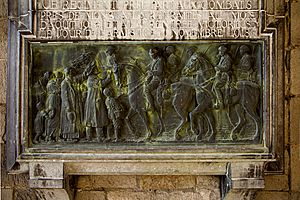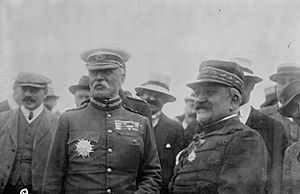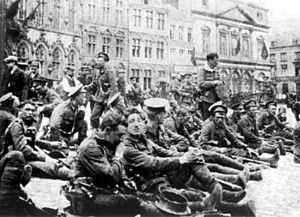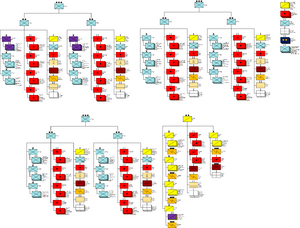British Expeditionary Force order of battle (1914) facts for kids
The British Expeditionary Force (BEF) was the main part of the British Army sent to France at the start of World War I in August and September 1914. Unlike the armies of France and Germany, which mostly used conscripts (people forced to join the army), the British Army was made up of professional soldiers who volunteered. It was also much smaller than the French and German armies.
The BEF was created thanks to changes made to the British Army, especially the Haldane Reforms of 1907. These reforms helped shape the modern British Army and set up the idea of an "Expeditionary Force" that could be sent quickly overseas. When World War I began, the BEF, which had six divisions, was quickly sent to the European continent.
This article explains the different parts of the BEF, including its fighting units like engineers and artillery. It does not include medical, supply, or communication units. Commanders are listed for larger groups like brigades and divisions.

Contents
Plans for the BEF
Before the war, the plan was to create an expeditionary force from the regular British Army in the United Kingdom. This force would have six infantry divisions and one cavalry division. This meant 72 infantry battalions and 14 cavalry regiments, plus support units.
The original idea was for General Headquarters (GHQ) to control all seven divisions directly. However, when the war started, it was decided to create two (and later three) larger command groups called "corps." This was done to match the way the French army was organized. These corps commands had to be set up quickly.
At first, there were worries that Germany might try to land troops on the east coast of England. Because of this, two divisions were kept in Britain for home defense. Only four infantry divisions and the cavalry division were sent to France initially. The 5th Division was sent at the end of August, and the 6th Division followed in early September.
General Headquarters (GHQ)
The first Commander-in-Chief of the BEF was Field-Marshal Sir John French. He was the top commander of the entire force. His Chief of Staff was Lieutenant-General Sir A. J. Murray. Other important staff officers helped manage operations, intelligence, administration, and supplies.

GHQ Engineer Units
The General Headquarters also controlled special engineer units. These included:
- Bridging Trains (for building bridges)
- Siege Companies (for building siege works)
- Railway Companies (for managing railways)
- Fortress Companies (for building defenses)
- A Printing Company (for maps and documents)
Cavalry
The British Army did not have a permanent cavalry division before the war. When the army was mobilized, the 1st, 2nd, 3rd, and 4th Cavalry Brigades were brought together to form a division. The 5th Cavalry Brigade remained a separate unit.
Later, on September 6, the 3rd Cavalry Brigade joined the 5th Cavalry Brigade. This combined force was renamed the 2nd Cavalry Division on September 16.
Cavalry Division
The Cavalry Division was led by Major-General Edmund Allenby. It included four cavalry brigades:
- 1st Cavalry Brigade
- 2nd Cavalry Brigade
- 3rd Cavalry Brigade
- 4th Cavalry Brigade
This division also had its own artillery units (Royal Horse Artillery) and engineer units.
Independent Cavalry Brigade
- 5th Cavalry Brigade was a separate unit. It also had its own artillery.
I Corps
I Corps was commanded by Lieutenant-General Sir Douglas Haig. He had senior staff officers for his Chief of Staff, artillery, and engineers.
1st Division
The 1st Division was led by Major-General S. H. Lomax. It included three infantry brigades:
- 1st (Guards) Brigade
- 2nd Infantry Brigade
- 3rd Infantry Brigade
The division also had mounted troops (like Hussars and cyclists), several Royal Field Artillery brigades, and engineer companies.
2nd Division
The 2nd Division was commanded by Major-General C. C. Monro. It also had three infantry brigades:
- 4th (Guards) Brigade
- 5th Infantry Brigade
- 6th Infantry Brigade
Like the 1st Division, it had mounted troops, Royal Field Artillery brigades, and engineer companies.
II Corps
II Corps was first commanded by Lieutenant-General Sir James Grierson. Sadly, he died on a train on August 17. General Sir Horace Smith-Dorrien took over command on August 21.
3rd Division
The 3rd Division was led by Major-General Hubert I. W. Hamilton. It included three infantry brigades:
- 7th Infantry Brigade
- 8th Infantry Brigade
- 9th Infantry Brigade

This division also had mounted troops, Royal Field Artillery brigades (including howitzers), and engineer companies.
5th Division
The 5th Division was commanded by Major-General Sir C. Fergusson. It included three infantry brigades:
- 13th Infantry Brigade
- 14th Infantry Brigade
- 15th Infantry Brigade
This division also had mounted troops, Royal Field Artillery brigades (including howitzers), and engineer companies.
III Corps
III Corps was formed in France on August 31, 1914. It was commanded by Major-General W. P. Pulteney.
4th Division
The 4th Division arrived in France on August 22 and 23. It was commanded by Major-General T. D'O. Snow. It included three infantry brigades:
- 10th Infantry Brigade
- 11th Infantry Brigade
- 12th Infantry Brigade
This division also had mounted troops, Royal Field Artillery brigades (including howitzers), and engineer companies.
6th Division
The 6th Division sailed for France on September 8 and 9. It was commanded by Major-General J. L. Keir. It included three infantry brigades:
- 16th Infantry Brigade
- 17th Infantry Brigade
- 18th Infantry Brigade
This division also had mounted troops, Royal Field Artillery brigades (including howitzers), and engineer companies.
Other Army Units
Besides the main corps and divisions, the BEF also had other important units:
- Mounted Troops: A special regiment made up of squadrons from the North and South Irish Horse.
- Siege Artillery: Several Siege Batteries from the Royal Garrison Artillery, used for heavy bombardment.
- Infantry: The 1st Battalion, The Queen's Own Cameron Highlanders, served as an independent infantry unit.
Royal Flying Corps
The Royal Flying Corps (RFC) was the air arm of the British Army. Its units in France were commanded by Brigadier-General Sir David Henderson. The RFC had several aeroplane squadrons that helped with scouting and observation.
Lines of Communication Defence Troops
These units were responsible for protecting the supply lines and communication routes that kept the BEF running. They included several infantry battalions.
Unit Strengths
Here's a quick look at the size of the units:
- A cavalry regiment had three squadrons and two machine guns.
- An infantry battalion had four companies and two machine guns.
Artillery units had different types of guns:
- Royal Horse Artillery batteries had six 13-pounder guns.
- Royal Field Artillery batteries had six 18-pounder guns or six 4.5-inch howitzers.
- Heavy batteries of the Royal Garrison Artillery had four 60-pounder guns.
Each artillery battery had two ammunition wagons for each gun.
In September, each division also received an anti-aircraft detachment with 1-pounder pom-pom guns.
The Cavalry Division (not counting the 5th Cavalry Brigade) had about 9,269 soldiers, 9,815 horses, 24 guns, and 24 machine guns. Each infantry division had about 18,073 soldiers, 5,592 horses, 76 guns, and 24 machine guns.
Units Not Sent to France
The British Expeditionary Force represented about half of the British Army's fighting strength. As a large empire, Britain needed to keep many soldiers in overseas garrisons (military bases). Home defense was handled by volunteer forces and reserves.
In July 1914, the regular army had 125,000 soldiers in the British Isles, 75,000 in India and Burma, and 33,000 in other overseas locations. There were also many reserve soldiers and volunteers.
Home Service
Before the war, 81 infantry battalions and 19 cavalry regiments were usually stationed in the British Isles. Some of these were kept for home defense, especially in London, due to concerns about unrest. These units were later joined by the Territorial Force, a volunteer army that was called up when the war started. Many Territorial units volunteered to serve overseas, with the first ones arriving in France in November.
Overseas Service
Many British Army units were stationed around the British Empire. For example, 48 infantry battalions and 9 cavalry regiments were in India. Other units were in places like Malta, South Africa, and Egypt. These forces were not initially expected to join the BEF. However, some units from India were later sent to France in October.
Most of the overseas garrison units were eventually replaced by Territorial battalions. New regular divisions were then formed in the United Kingdom. However, none of these units arrived in time to serve with the original British Expeditionary Force.
See also
Images for kids



